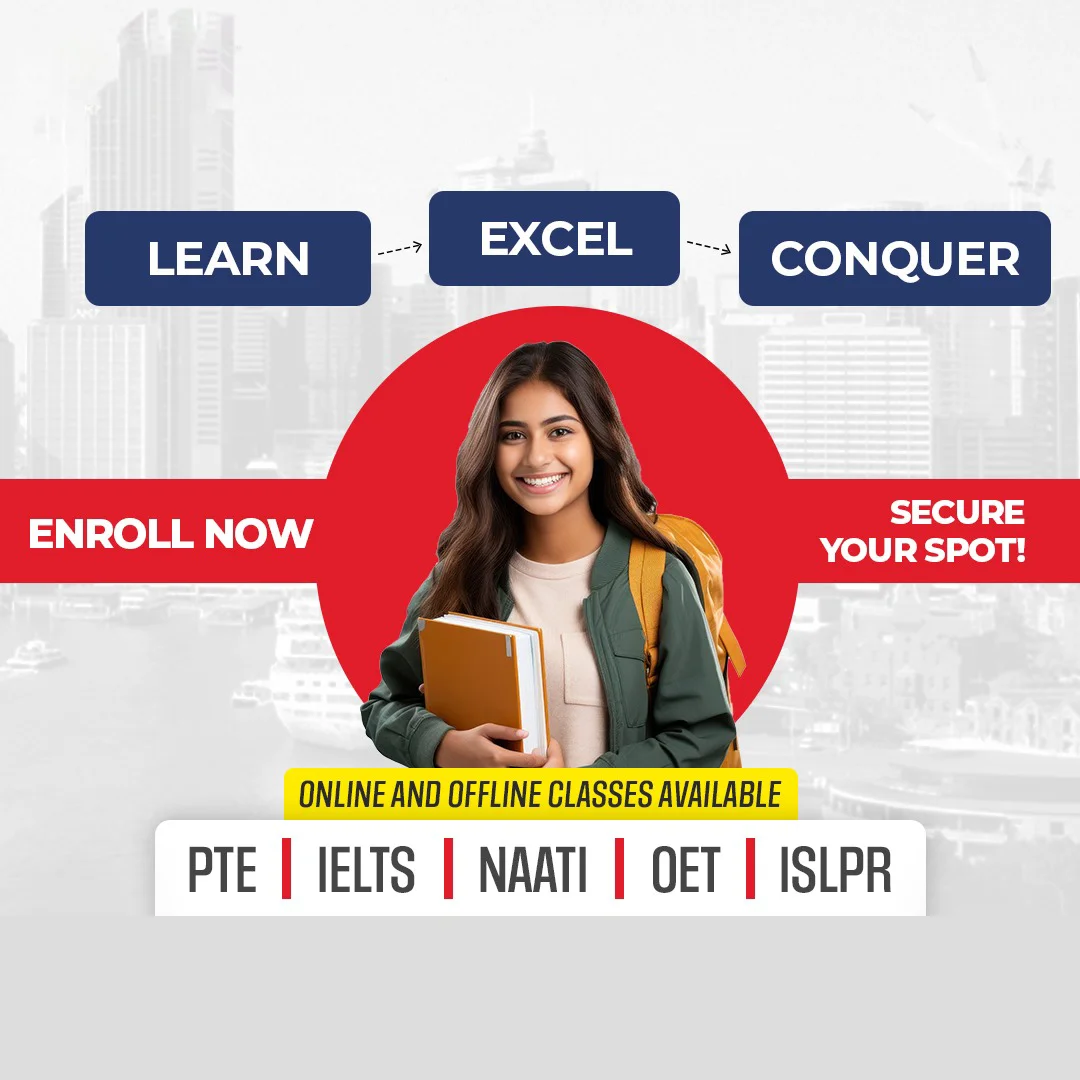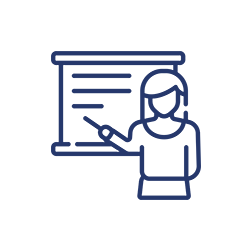Your Best Choice for Online & Offline IELTS Classes in Perth
Reliable IELTS prep is more than memorising tips. We at EnglishWise understand this and provide hands-on material and tips for the best results. It’s about building skills that hold up under pressure. Our Online IELTS Coaching in Perth, along with in-person options, lets you choose what fits your week. Some people appreciate the convenience of logging in from home. Others want the focus of a classroom setting.
In our IELTS Classes in Perth, you’ll cover speaking, listening, reading, and writing at a steady pace. We explain the reasoning behind every technique so you can apply it on your own. If something’s tricky, we don’t move on until it makes sense.
You’ll tackle practice tests that feel just like the real thing, receive feedback that zeroes in on what matters, and follow a plan built around your exact score goals. Whether you’re aiming to study abroad, make a fresh start through migration, or take the next step in your career, our IELTS Coaching in Perth keeps your prep focused, practical, and free from any unnecessary extras.
What You Get At EnglishWise Perth
ALL PTE preparation materials (included in the course at no extra cost)
PTE Booklet
PTE Real Exam Simulation Software
Monthly Prediction Files
5 Full Mock Tests Assessments Worth $200 (100% Free)
100+ hours of Coaching and Assessments
Unlimited Practice at Institute! Mon – Sun
Online PTE Practice software Access – 6 months
Personal and Private Feedback STRATEGIES + TECHNIQUES for All 4 PTE Modules
4 X 15 minutes Private Consultation with PTE Expert Assistance in booking PTE Exam
PROPER COMPUTER LAB FOR practicing Mock tests in Real exam environment
Advance & one on one feedback sessions in the lab included
Online Coaching Classes Package
Payment gateway options (Visa, Mastercard, Stripe, Afterpay – 4 interest-free payments)
Trusted IELTS Training Institute in Perth
Why IELTS Stays on Top
The IELTS test — a name that pops up early for anyone planning life beyond their home country. It’s a common step for migrants aiming to study abroad, whether for a full degree, a short-term program, or professional accreditation. For most, it’s the first checkpoint in their journey — evidence that they can read, write, listen, and speak English well enough to succeed in lectures, offices, and daily conversations overseas.
The IELTS exam also works around your life. You can choose paper-based or computer-based testing, with dates running all year, so even if your week’s packed, you can usually find one that fits.
The skills it checks—listening, reading, writing, and speaking—are the same ones you’ll use in study, work, or daily life. You can even retake just the section you want to improve, without starting from scratch.
For many, IELTS strikes the perfect balance: recognition, flexibility, and a test that feels practical.
Why Join Our IELTS Classes
From the start, our Online IELTS Coaching in Perth lays out the entire plan—lessons, tasks, practice exams, and feedback, all mapped out with room to adjust as needed. Your time is valuable, and so is our commitment to your results, so every part of our curriculum is built with that in mind.
Online learners join live or catch up with recordings. In-person IELTS Classes in Perth mean you get direct, face-to-face time with trainers who understand the test inside and out. Both give structure, but not the kind that boxes you in.

We work for steady improvement, not just quick fixes. Weak spots receive more attention, while strong areas are refined rather than being repeated endlessly. By test day, you’ll have a straightforward approach for each section, plus the timing to match.
If you’re after preparation that’s organised, realistic, and designed for your actual goals, our IELTS Coaching in Perth gives you a straightforward path ahead.
IELTS Academic Test Structure
A clear understanding of the IELTS test structure is essential for effective preparation. Familiarity with the format allows one to allocate their time appropriately during the exam and practise skills relevant to each component. The IELTS Academic test comprises four sections — Listening, Reading, Writing, and Speaking, each designed to assess specific aspects of English language proficiency in an academic or professional context.
We provide comprehensive training across all test sections –
- Multiple Choice
In this question, you will listen once to an audio recording and select the correct answer/answers from the given options. The questions appear in the same sequence as the information in the recording. You have to recognise meaning, identify paraphrases and avoid distractors that may sound convincing but are incorrect. - Matching
This task involves connecting numbered items to a list of possible matches, such as linking speakers to opinions or locations to activities. You have to follow the flow of ideas, notice changes in context and interpret tone or emphasis. It can help you reveal the answer more clearly than vocabulary alone. - Plan, Map, Diagram Labelling
While listening, you complete missing labels on a plan, map, or diagram. Understanding spatial language and sequence is essential, as a wrong placement will cost the mark. The task tests the ability to visualise descriptions accurately while observing spelling rules and following any stated word-limit requirements.
- Form, Note, Table, Flow-chart, Summary Completion
In this question type you transfer specific details from the recording into a provided outline. The content may or may not follow a logical order. While answering you must ensure the grammar fits, meaning remains accurate, and no extra words are added. - Sentence Completion
You fill in the blanks of given sentences using exact words or short phrases from the audio. The completed sentence must be grammatically correct and preserve the intended meaning. The recording may use synonyms rather than identical terms, so recognising equivalent expressions is essential for choosing the right answer. - Short-Answer Questions
This requires brief factual answers, such as names, dates, or numbers. The questions follow the order of the recording, so missing a detail means losing the mark. Correct spelling and strict adherence to word limits are essential.
- Multiple Choice
Select the answer that best matches the question or completes the sentence. The sequence of questions reflects the passage’s order. This task measures the ability to locate evidence, interpret meaning accurately, and reject options that appear plausible but are not fully supported by the text. - Identifying Information (True/False/Not Given)
Determine whether each statement agrees with the passage, contradicts it, or is not included. The only correct responses are True, False, or Not Given. Outside knowledge should not be applied. Although questions follow the text’s order, careful reading is required to detect even subtle shifts in meaning. - Identifying Writer’s Views (Yes/No/Not Given)
You decide if a statement agrees with the writer’s view (Yes), disagrees (No), or is not stated (Not Given). It tests recognition of opinion and tone rather than factual agreement. - Matching Information
Find the location of specific details in the text and match them to their correct paragraph. Paragraphs are labelled with letters, and some may contain more than one answer. Skimming for keywords is helpful, but confirming surrounding context ensures the match is accurate and avoids misinterpretation. - Matching Headings
Choose a heading that represents the main idea of a paragraph or section. Supporting details or examples should not guide the choice, as they can be misleading. Some headings will remain unused. This task rewards the ability to identify central themes clearly and efficiently. - Matching Features
Link statements or pieces of information to the correct person, group, or category. Options may be used multiple times or not at all. Answers often require combining information from different parts of the passage, making it essential to read for meaning rather than just matching words.
- Matching Sentence Endings
Complete each sentence beginning by selecting the correct ending from a given list. The result must form a complete and accurate statement supported by the passage. Questions typically follow the order of the text. Understanding the logical relationship between ideas is more important than matching vocabulary alone. - Sentence Completion
Fill in missing words from the passage to complete the sentence. The answer must meet the word-limit requirement and be grammatically correct. Often, the text rephrases the same idea differently, so scanning for synonyms and equivalent expressions is essential to finding the correct answer. - Summary, Note, Table, Flow-chart Completion
You complete a summary, table, or flow-chart using words from the passage or a provided list. The sequence of information may not match the text exactly. Grammar must fit naturally, and answers must follow the given word limit to be considered correct. - Diagram Label Completion
Complete a diagram with missing labels using words from the passage. The diagram may show an object, process, or system. Answers must be spelled correctly and follow any stated word limit. The task requires linking textual descriptions to the visual representation accurately. - Short-Answer Questions
Provide concise answers using words taken directly from the passage. Adhere strictly to the word limit and spelling rules. Locating exact details quickly is key, while avoiding similar but incorrect information that may appear elsewhere in the text. No rephrasing or additional interpretation is permitted.
- Task 1 (Academic)
Write at least 150 words describing visual data such as a graph, table, chart, or diagram. Summarise main features, compare key points, and explain processes when required. Keep tone formal and factual, with information presented in a logical order. Avoid personal opinion or irrelevant detail.
- Task 2 (Academic)
Produce a formal essay of at least 250 words in response to a given problem, argument, or viewpoint. Present a clear position, support it with evidence or examples, and organise ideas logically. Correct grammar, varied vocabulary, and full coverage of the prompt are required for a high score.
- Part 1: Introduction and Interview
In this 4-5 minute section you will have to cover familiar topics such as work, studies, home life, or hobbies. Your responses should be clear, relevant, and delivered naturally without memorised phrases. Assessment focuses on fluency, coherence, and the ability to discuss everyday subjects in a formal context. - Part 2: Long Turn
You receive a topic card with prompts, have one minute to prepare, and then speak for one to two minutes. Cover all points, maintain logical organisation, and support ideas with examples or explanations. The focus is on sustained, coherent speech without constant prompting.
- Part 3: Discussion
This 4-5 minute discussion explores broader issues linked to Part 2’s topic. The examiner assesses your ability to express and justify opinions, analyse ideas, and consider alternatives. A wide vocabulary, clear reasoning, and confident delivery are important for a strong performance.
IELTS General Training Test Structure
A thorough understanding of the IELTS General Training test format is vital for effective preparation. Knowing the structure helps you allocate time wisely and focus on the skills required for each section. The test consists of four parts – Listening, Reading, Writing, and Speaking, each assessing practical English skills for daily life and workplace situations.
We offer detailed training for every section of the test –
- Multiple Choice
You’ll hear a recording and pick the right answer from a few options. It’s not always obvious, and you might find yourself second-guessing at times. Focus on key words and phrases that stand out, they’ll guide you to the answer. And don’t stress if you miss something small. - Matching
This one’s about matching speakers or ideas with options from the recording. Pay attention to what people are saying and how they say it. In most cases, tone or phrasing gives away who’s saying what, so just focus on those little details that connect the dots. - Short Answer
Answer the questions with one or two words directly from the recording. It’s pretty straightforward, but sometimes the info can be a little buried, so stay on your toes. Often, it’s numbers, names, or facts and that can trip you up if you're not paying attention.
- Sentence Completion
Complete sentences with words from the recording. The missing words are usually key facts, names, or descriptions, so listen for those. It can be tricky, but if you get the context around the blank right, it usually leads you to the correct answer. - Plan/Map/Diagram Labeling
You’ll label a diagram, map, or plan based on what you hear. Descriptions will talk about locations, processes, or steps. It’s like putting together a puzzle, just listen for where things are and match them to the right spots on the diagram. - Form/Note/Table/Flowchart/Summary Completion
Fill in forms or tables using info from the recording. You’re looking for specific details like dates, names, or locations. The key here is making sure the facts match exactly with what you hear — one wrong number can throw off the whole answer.
- Multiple Choice
Read a passage and pick the right answer. The questions could ask for specific details, the general idea, or even the writer’s tone. Some answers might feel right, but you’ll need to dig a bit deeper and catch the finer details that make one answer stand out over the others. - Identifying Information (True/False/Not Given)
You will read statements and decide whether they are True, False, or Not Given based on the information in the passage. "True" means the statement agrees with the information in the text, "False" means the statement contradicts the information, and "Not Given" means the information is not mentioned in the text. - Identifying Writer’s Views/Claims (Yes/No/Not Given
Here, you decide if the writer agrees with a statement. "Yes" means they support it, "No" means they don’t, and "Not Given" means you can’t tell. The tricky part is figuring out the writer’s stance, but if you pay attention to tone, it usually gives you clues. - Matching Information
You match statements or pieces of information to specific parts of the text. This could involve matching opinions, facts, or ideas to the correct paragraphs. It's essential to find the right location in the text that directly supports the matching information, ensuring clarity and relevance in your answers. - Matching Headings
Match headings to paragraphs. Each heading should sum up the main idea of that section, so it’s about getting the overall vibe of each paragraph. Look for the sentences that stand out the most to help make the right connection.
- Matching Features
Match names, characteristics, or descriptions to the right parts of the text. This is like matching a name to a face, so pay attention to distinctive details that will help you link them correctly. - Matching Sentence Endings
You’ll finish sentences by picking the right ending. The key is connecting the first part of the sentence with an ending that makes sense. It’s not just about memorising details, you need to understand how the ideas connect. - Sentence Completion
Fill in the blanks in sentences using words from the text. The missing words should fit both grammatically and in terms of meaning. Read around the sentence and pick up on any clues that’ll tell you which word belongs. - Summary Completion
Complete a summary using words or phrases from the passage. This tests how well you understand the main points and how you can paraphrase them in your own words. The trick is to catch the important details and pick the words that summarise them best. - Note/Table/Flowchart Completion
Fill in notes, tables, or flowcharts with details from the text. This is about organising the info you get and fitting it into the right sections. It’s kind of like filling in blanks on a form, everything needs to be in the right place. - Diagram Label Completion
You’ll label a diagram based on the passage. It could be a process or system, and the goal is to place the labels in the correct spots. Just listen for how things are described in the text, then match them to the diagram sections.
- Task 1: Letter Writing
Write a letter based on the situation you’re given. The tone can be formal or informal, depending on what’s needed. Whether it’s a request, complaint, or application, just make sure to cover all points clearly, and keep your tone appropriate to the situation.
- Task 2: Essay Writing
Write an essay in response to a question. Present your opinion clearly, support it with examples, and explain your reasoning logically. Make sure your essay has a clear structure: intro, body, and a solid conclusion that wraps everything up.
- Introduction and Interview
The examiner will ask general questions about you – your hobbies, your background, and daily life. This is where you show how naturally you can talk about yourself. Don’t just give short answers, though. Expand on your responses and add details to show your fluency. - Long Turn
You’ll speak about a given topic for 1-2 minutes. The examiner will give you a few points to guide you. Take a second to gather your thoughts before speaking, and try to say enough to fully cover the topic without going off track.
- Discussion
The examiner will ask follow-up questions based on the topic you just spoke about. This is your chance to dive deeper and discuss the topic in more detail. Be prepared to expand on your ideas and express your thoughts clearly.











